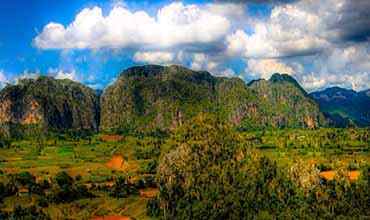
Viñales
Around Viñales, in the western province of Pinar del Rio, are a unique string of rounded limestone mountains called mogotes; in their shadows are the lush green fields that produce the world's finest tobacco leaves.

Whether you are visiting Cuba individually or in a group, you will want to get to know its rich history and explore its amazing natural wonders. Cuba is a unique country. It’s culture and history, amazing beaches, warm and friendly people make Cuba the most interesting Caribbean destination.
An excellent way to add more adventure and culture to your vacation is through organized tours and excursions. We can select the activity which best fits your needs and interests.
The excursions start from various destinations and can take few hours or few days. All excursions are designed to personalize your vacation and satisfy the most diverse interests. You are sure to find an excursion to suit you…from trips to beautiful beaches or exploring unique landscapes, to learning about the architectural treasures of Havana, you can select from a large variety. Excursions can take place during the day or night and are complemented by meals at local restaurants serving authentic Cuban food. Whatever you choose, our excursions will lead you to discover the many facets of Cuba!
Havana: dance, theatre, museums, history, architecture, nightlife, beaches – the Caribbean’s largest and most cosmopolitan city really does have it all. Take in a dazzling floorshow at the famous Tropicana nightclub, cruise along the picturesque Malecón Seawall Drive for unrivalled views of the city and the sea, or stroll through the heart of Vieja Habana [Old Havana] to explore architectural and historic landmarks such as Cathedral Square and the Presidential Palace. Experience the magic that has inspired renowned writers from Ernest Hemingway to Federico Garcia Lorca, right here in Cuba’s legendary capital.
Advisory: Legal aspect Advisory: All the personal information that you bring us will be only for subjects of your reservation in Cuba, we will never send an email like SPAM, only those with answers for questions you ask us and your mail address as well as any other information who offer us will maintain strictly confidential. Your email address, personal data and any other data provided by you, never will not be provided third persons, nor to other organizations, groups or companies.
Advisory: Travels to Cuba for US citizens may be eligible under the “General License”, which is a do it yourself authorization, no further application is required.
Vaccinations:- There are no compulsory vaccinations required for Cuba travel; however, the following Vac’s are advisable as a sensible precautionary measure – and may be required to satisfy your Travel Insurance Policy. You will need these Vac’s at least 2 weeks prior to travel but preferably at least 2 months prior. These vac’s are available from your GP Surgery/Travel Clinic and are generally offered free of charge. In our opinion it would be both sensible and advisable to have these ‘basic’ vaccinations no matter where your holidays may take you:-
Typhoid:- The disease is transmitted from human to human via food or drinking water, and it is therefore mainly hygiene and sanitary conditions that determine its spread.
Hepatitis A:- This virus is present in stools passed by infected persons. It can be transmitted via contaminated food, eg shellfish and ice-cream, as well as contaminated water and beverages. The virus can also be spread through contact with an infected person's stools through poor hygiene.
Diphtheria:- This disease is mainly transmitted by droplets from the nose or throat being passed from person to person, eg by coughing or sneezing. Protection from the disease comes from having antibodies in the blood - which is the purpose of vaccination. The bacteria can easily be passed on by a person who shows no sign of illness, a so-called 'healthy disease carrier'. Diphtheria can also be transmitted by skin-to-skin contact . Also Tetanus and Polio should be up to date. Assuming your travel vac’s are not up-to-date, it will be important to have your boosters (within 6 months) of your initial jabs ~ having the boosters will give you 10 years cover with the exception of Typhoid which you will need to have every 3 years.
Currency and Credit Cards:- Cuban currency is not traded internationally, so you can’t buy it in advance. There are 2 currencies in use in Cuba – The CUC (Cuban Convertible Peso) which is the Tourist Currency and the CUP (Cuban Peso) which is the locals currency. The CUC is the only currency you will likely be using during your trip. You can only exchange your money into CUC’s once you are in Cuba. You can exchange your Sterling £’s at the exchange booth at the airport (but remember you could be holding your bus up if there is a queue)(one of you wait for the luggage whilst the other goes to the exchange) or most Hotels and Resorts have an exchange booth which offer an exchange rate much the same as the airport. You must make sure your GBP £notes are in good condition with no rips or writing or defaced as these can be declined, I would exchange a little cash at a time so as not have too many surplus CUC's when you leave or otherwise you will have to pay to re-convert them into £££'s. Remember to keep back a few cuc’s for drinks/food at the airport and your final tips!! REMEMBER you will need to exchange and put by 25 cuc’s per person ( in notes – no coinage accepted) for your exit tax. To get an idea of currency conversion take a look at this website, your destination currency will be CUC (not cup), you can print yourself a cheat sheet to keep in your purse/wallet to help with converting prices into £’s (you can also reverse the cheat sheet) print a copy just before you leave so that you will be comparing at more recent exchange rates – It’s good as a rough guide !! http://www.oanda.com/convert/cheatsheet
Travellers Cheques are a pain in the butt to cash and if you lose them you will not get them replaced in Cuba so IMO they are a waste of time. TC’s must not have any American affiliation or they will be declined; to find such TC's is very difficult here in England - not sure about Wales or Scotland . So I would stick with cash. Your resort will have a room safe so be sure to store all your valuables in there. If you do decide to take TC’s be sure to take the original receipt and your passport with you to the bank or else they will not cash your TC’s.
American Dollars are no longer advisable in Cuba , contrary to popular belief the dollar is still accepted in Cuba and is not ‘illegal’ – If you exchange dollars you will be charged a 10% commission over and above the usual rate of exchange so it’s not worth the bother plus you will end up losing around 20%.
Debit Cards:- VISA Debit cards are a bit of a grey area, Cashpoint machines are not widely available in Cuba and don’t always work, so I would personally forget about using your VISA Debit Card in Cuba . If you withdraw cash you will be charged between 11 and 13% by the bank.
TRAVEL INSURANCE:- You would be mad to travel to Cuba without adequate Insurance including medical insurance. Make sure your Insurance Provider WILL honour your policy should you need medical treatment in Cuba, there was a recent case where a lady needed medical treatment in Cuba but because her policy was from an American affiliated provider they would not help her whilst she was on Cuban soil, fortunately her injuries were not too serious or require hospitalisation – ask your Insurance Provider to confirm in writing that you are covered for everything whilst INSIDE of Cuba. (this is where a Credit Card will always come in handy – any medical treatment MUST be paid for before being allowed to leave Cuba ). Also it is advisable to choose an Insurer that has a ‘manned’ 24hr helpline – If you phone the helpline be sure to have the number of your hotel so you can request they phone you back immediately, telephone calls are very expensive in Cuba and you will end up with a huge bill, especially if you are using a hotel phone. I know a family that had a medical emergency and were unable to get hold of their Insurers all weekend – they had to pay for all the hospital treatment and xrays, ambulance service etc themselves, they also ran up a huge phonebill trying to get hold of their insurers….. that also had to be paid by themselves. Always ensure you have a copy of your policy and all emergency phone numbers with you. extra info click here.
Tourist Card/Visa:- You will need a green Tourist Card/Visa to gain entry into Cuba . Some Travel Agents include the Visa in with your holiday cost and some don’t, you will need to check with your Agent. The cost of the Visa is usually £15 and can be obtained from the Cuban Consulate in London. If you need your Visas in a hurry you can apply on-line @ www.cubavisa.uk or www.visacuba.co.uk – this will cost you more than £15. When you fill in your Visa you will need to make sure you do not make any mistakes, so read the card thoroughly and carefully before filling in. Beware of the date of birth section as this is done in a different format to what we are used to using – I think it is done in month, date, year order. You will be able to find a sample Visa on the internet. Both parts of the Visa have to be completed and handed in to Immigration on arrival, they will retain one half and give you back the other half; which you must keep safe and hand in to immigration on departure. Some Travel Agencies will allow you to purchase a Visa at their travel desk at the airport, they usually charge £20 – check with your Agent, do not depend on it!!!!! You may learn that you can buy a Tourist Visa on entering Cuba ; however, some British Operators will not allow you to board your flight without your Visa so do not rely on this option or you may not be Cuba bound!
Immigration:- Immigration in Cuba can be a bit nerve racking, you will queue to enter an immigration booth, you can only go one person at a time, you will be required to hand over your passport and Visa, the passport will be scrutinised and so will you….lol… you will most likely feel uncomfortable and they may ask you a simple question, a simple answer is the best reply!!! If you have children, you can take them to the booth with you, but it is better to ‘share’ them between mum and dad than go to a booth ‘on mass’ ~ do not go to the booth as a whole family – you will be turned back. If you have older children (teenagers+), let one adult go first, then the older child and then another adult, this way; if by chance the ‘child’ is sent for interview there is an adult on the same side of immigration as the child and you can demand to go with your ‘child’ ~ I have only ever heard of this happening once before, where both adults were on the other side of immigration and they would not let the parents go back to be with the ‘child’ ~ could be True or False?Keep a copy of the photo page of your passport in case your documents are stolen.
Cameras & Batteries:- Films for cameras are expensive so make sure you take plenty of film with you. Batteries are expensive and hard to get, so make sure you have plenty of spares for the likes of your cameras, MP3, Ipod etc. An underwater disposable camera is one of my ‘musts’, you can get some fabulous pictures of the coral and fish. If you have a digital or video camera – remember to pack your chargers --- Hope you have a big memory card too !!!!!
Telephone Calls and Mobile Phones:- If you wish to make a phonecall the best option is to purchase a pre-paid phonecard (usually available on resort) and use the public cardphone. Calls from the Hotel phones are much more expensive than the public cardphones. All telecommunications are very expensive in Cuba. Using a mobile phone is probably the cheapest option, but still approx charged at £1+ a minute. The cheapest form of contact is text (approx 45p). If you are taking your mobile to Cuba be sure to tell folk NOT to phone you and certainly not to leave you a voice mail unless in an emergency – you have to pay to receive the call and if a voice mail is left you have to pay to receive the voicemail, then pay again to listen to it and you also have to pay to store the message on the Cuban net work – that one call can cost you a fortune; especially if you don’t retrieve your message for a few days. Remember Text is best and cheapest. Most Mobiles work in Cuba, it does not depend on the ‘band’ of your phone but on your network provider, it is best to phone your service provider and check whether your particular phone will work in Cuba. You can access your providers website to get the current charges for calls and texts for Cuba . Remember, anything incoming, other than texts, you are paying dearly for. The Code for England from Cuba is 044- then drop the first 0 from the area code followed by the telephone number – you may have to apply this practice when phoning a mobile from Cuba.
Medications etc:- Any medication is not widely available in Cuba so be sure to take enough prescription medications for the whole of your trip. You will also need to ensure you take general first-aid with you – pain killers, plasters, Immodium, hydration salts etc, as these are both costly and difficult to get hold of in Cuba. If you have an allergy to any medication ensure you bring an alternative with you. Please, whatever you have left over pass on to any Cuban folk as they will be most appreciative of it, medications are unaffordable to them. Condoms are a must, for obvious reasons, and expensive to purchase!!
Ladies; please take tampons and sanitary wear with you, if the unexpected should happen you will be up pooh alley! You can not get tampons in Cuba and their ST’s are rather antiquated and nasty!!! Be sure to leave any unwanted tampons with a Cuban – she will remember you for ever. Take little packets of tissues with you; toilet paper is scarce or chargeable (off of resort, of course…lol), they are handy to have at the airport. Baby wipes might be an asset on resort as the loo paper can be quite thin and cheap in some resorts….lol…lol.
Sun Lotions:- Take plenty of sunscreen, various factors and after-sun – expensive in Cuba but a cheap product, also anything for sunburn, the sun is very hot so be careful. A hat, especially if you are bald or have thin hair.
Mosquito’s & Bugs:- Take repellent, products that contain 50% Deet are very good ~ these include – Jungle, Tropical strength or Boots chemists do their own Tropical strength repellent. Maybe a mosquito plug-in for your room. Take after-bite lotion and tablets to relieve itching, Benydryl is a good brand, also zapper pens or the bite pens that contain ammonia. I also take a spray can of Raid (red tin) in case I get any uninvited visitors, such as roaches, ants etc. (once the spray is applied to troublesome areas, such as balcony doors; it will deter them from coming back) TIP: I always leave the bathroom light on and keep the plug in the bath to help avoid getting roaches. Again, leave the can with a Cuban. Sand fleas can be an issue sometimes too – the evidence of sand flea bites are bites on the feet, ankles and lower legs … but not anywhere else …. I do not know of a repellent but some good sound advice is to exchange your dirty beach towels at the end of a day for clean ones … do not take dirty beach towels to your room, or you could be taking the sand fleas in with you.
FOOD:- Food is very basic in Cuba so don’t go there expecting fine cuisine. If you like to have nibbles in your room then I suggest you take your own, choice is very limited in Cuba and does not taste like ours, things I would suggest you take are:- Crisps and pringle type eats – Cuban ones are naf, chocolate and sweets. Peanuts, biscuits, nutrigrain bars etc & chewing gum. Salad Cream or Mayo – if you cant live without it (none in Cuba ).
Travel Adaptor:- Most resorts have dual power supply 110v and 220v so you can use either the Southern Europe round pin adaptor or the Australian/American square pin adaptor – all our appliances in the UK are 220v so you will not need a converter. If you use the round pin adaptor (110v) your electricals will run slower
Towels:- Most, if not all resorts provide in-room towels and beach/pool towels that can be changed daily, so no need to pack any towels.
Car Hire:- If you are not a confident driver give this one a miss. You will also need a good map!!
Drugs:- Cuba has a zero tolerance on drugs, sniffer dogs are present in the airport and freely sniff your luggage. Cuba is increasingly being used as a transit country for drugs destined for Europe. Cuban law allows for the death penalty and courts are handing out very severe penalties (in excess of twenty years) for all drugs related offences. Do not take drugs in with you and do not accept from anyone offering you drugs (you could be accepting from under-cover cops).
Weather:- Cuba is generally hot all-year round. The months June to Oct/Nov can be very hot and very humid day and night. From Nov/Dec onwards the humidity drops, offering a much pleasanter climate if you don’t like high humidity – May/June time the humidity starts to rise again. May brings the start of the rainy season and the hurricane season which goes through to November now. Although it is the rainy season, it does not mean rain as we know it !! Any rainfall is usually just a 10-20 minute tropical downpour and then back to sunshine. Most rain usually occurs throughout the night. Dec to April is much cooler in the fact that you don’t have the humidity and can have a ‘cool breeze’ making the overall climate more bearable if you don’t like the extreme heat and like a bit of air !!! Cuba is great for a tan all year round.
Babies:- Baby food and disposable nappies are patchily available in Havana and normally unavailable in the rest of Cuba ; if you are bringing a baby it is always best to come self-sufficient and bring every thing you are likely to need for baby, including swim nappies, cereals, jarred and packet foods and juices (incase baby has a hard time adjusting to Cuban cuisine) snacks and nibbles. Bring spare dummies, bottle teats, sterilising wipes and tablets. Please also remember to bring any medications you could possibly need if baby was to fall ill. If baby has an allergy to any medications ensure you bring an alternative with you just incase baby should need it. Most doctors are sympathetic and will give you a prescription if you explain that you are going to Cuba and stress that medications are difficult to come by.
With almost 1,000 buildings of historic importance, this intimate quarter is perhaps the largest and most complete colonial complex in the Americas. Like a peopled “museum” full of animated street life, Old Havana boasts an astonishing wealth of castles, cathedrals, convents, palaces, and other important buildings spanning five centuries. An ongoing restoration program, now in its third decade, has transformed the finest structures into museums, hotels, restaurants, boutiques and trendy bars. Easily walkable, the cobbled plazas and the narrow, shaded streets of Habana Vieja exude colonial charm. Beyond Habana Vieja, Cuba's lively, colourful metropolis of two million people is a major attraction for its architecturally significant districts in various stages of dilapidation. Radiating inland from the harbour and coastline like a Spanish fan, Havana emerges from compact 19th-century barrios into more spacious 20th-century municipios and post-Revolutionary working class suburbs. Functional apartment blocks give way to once-noble, upper-class districts full of Beaux Arts, Art Deco, and Modernist mansions, while concrete office blocks, government buildings and hotels from the 1950s lend the city a retro feel.
The pine-clad mountains that begin a short distance west of Havana and run through northern Pinar del Rio province are a nature lover’s paradise of protected national parks sheltering endangered animals. The mountains grow more rugged westward, where dramatic rock formations called mogotes tower over lush valleys where tobacco plants thrive in the rich red soils and gentle climate. Centred on a village that itself is a National Historic Monument, the Valle de Vinales is rural Cuba at its most quintessential. Huge caverns beneath the mogotes provide a realm of possibilities for spelunkers.
Founded in 1514 by Diego Velaquez, Trinidad was declared a UNESCO World Heritage site in 1988. During the 17th and 18th centuries, the city was a wealthy slave-trading centre and hub of sugar production and its wealthy landowners and merchants erected fine homes and mansions. The cobblestone streets lined with pastel coloured houses have barely changed since the colonial era; Trinidad feels like an attraction that time has passed by. Unlike most cities in Cuba, Trinidad sits on a hill and is cooled by near-constant breezes.
On Cuba’s Caribbean side, Cienfuegos perches on the shores of Jagua Bay like a pearl sitting on an oyster shell. First settled by the French, who dubbed Cienfuegos “The Southern Pearl”, the city is the capital of Cienfuegos province. In the early 19th century, wealthy Frenchman D'Clouet of Louisiana promoted this area to the French, who began to populate the region from Bordeaux among other places. Today, this “Franco-Cuban” province produces sugar, citrus fruits, cattle and coffee while developing its industrial side as well. Well preserved French and indigenous architecture abounds in Cienfuegos. In the circular Martí Park, a granite compass marks the point where the first French villagers started building the city. The Terry Theatre built in 1869, is a good example of eclectic Creole architecture. Its history and legends are linked to international stars of the stage.
The country’s second-largest city has a flavour all its own, thanks to it being the most African city in Cuba and the most musical place in the island nation. Surrounded by mountains, Santiago was founded in 1511 on the hilly east shore of a deep flask-shaped bay. Its sloping colonial core is an attraction replete with noteworthy historic buildings, while its fascinating past as the first capital of Cuba is enriched by its importance as a hotbed of revolution. Fidel Castro studied here as a youth and later initiated the Revolution with an attack on the Moncada barracks. Santiago explodes with colourful frenzy during Carnaval each July.
Tucked inside a broad bay enfolded by mountains, Baracoa sits at the far Northeast corner of Cuba. This antique city was founded in 1511 as the island’s first settlement. When Governor Diego Velazquez later moved to Santiago, a long period of isolation set in. Locals claim that the Bahia de Miel was the site of Columbus’ first landing in Cuba in 1492, and that the flat-toped mountain he described is El Yunque, which rises dramatically behind Baracoa. Lined with venerable wooden houses in local, vernacular style, the sleepy town is laid out in a tight grid. A favourite with independent travellers, Baracoa today buzzes with crowds of tourists.
Being a most valuable natural reservoir that stands out nationally, regionally and worldwide, Ciénaga de Zapata National Park is the main core area of the Biosphere Reserve and the Ramsar site that have the same name. Natural and socio-economic characteristics of this territory make it be a priority area due to the ecological fragility of its ecosystems, its values for the conservation of biodiversity and other natural resources. It is an extensive ecosystem made up of mangrove forests, keys, seagrass beds, coral reef barriers and deep reefs, including the Cazones Gulf, a deep underwater canyon that is the main recruitment site of important commercial species such as porgies and groupers. The conservation status of coral reefs in the area is most remarkable. It comprises an important system of gyre-like currents.
Cuba is an infinitely fascinating country and undoubtedly different from most places you’ve travelled. If you’re planning your first trip, take on board these Cuba travel tips from our expert co-author of the Rough Guide to Cuba, Matt Norman.
If you want to get to know Cuba you’re going to need to get to know Cubans. There’s no easier way of doing this on a two-week trip than to stay in the Cuban version of a B&B, a casa particular. You’ll feel more like a lodger than a hotel guest, sharing the owners’ living space with them and, given the national penchant for chat, engaging with them in next to no time.
2. Forget the internetAs far as the internet goes, Cuba is among the most poorly connected countries in the world, with severe state restrictions on who and where gets access, dreadful connection speeds and no mobile broadband other than wifi. Unless you are staying in or near a top hotel, don’t expect to be able to connect with your phone at all. You might just be lucky enough to find one of the few public wifi spots or patient enough to queue at one of the small number of internet cafés – where the connection will be screen-gazingly slow and the rates usually exorbitant. So unless you do all your online research before you leave home, bring a guidebook. A woman's hand holds a Daiquiri made with Havana Club rum at counter of Floridita Bar and Restaurant, Cuba, Havana.
3. Plan your nights outLeaving a night out to chance can be the making of a memorable one anywhere in the world, but in Cuba the chances are slimmer. Even in the holiday resorts, trying to find ‘the buzz’ or ‘the strip’, you’ll be on a hiding to nothing – there just aren’t enough venues and those that there are, in most towns and cities, are sparsely spread. Find out in advance where the night spots are, be prepared to spend some time travelling between them – especially in Havana where they are greater in number but dotted sporadically over a huge area (you’ll probably need to use taxis). If you find a venue you like, stick with it.
4. Know your pesos: men and monumentsThe confusing dual currency system in Cuba has spawned a whole family of local scams so it pays to get to know one set of banknotes from the other. Cubans get paid in pesos, also referred to as national pesos; the faces of peso banknotes are printed with head-and-shoulders-pictures of Cuban heroes. You’ll pay for most goods and services in convertible pesos, twenty-four times more valuable than national pesos; depicted on these banknotes are national monuments but their values are printed as pesos, just like their counterparts. The words pesos convertibles only appears in a smaller font below the value. Paying in convertibles and getting change in nationals is the most popular trick and there are a few spin-off scams along similar lines. Just remember, twenty-four men equal one monument.
5. Eat out in paladarsEating out in Cuba is no longer as bad as you’ve probably heard. The reputation for the same, unimaginative, mono-flavoured cooking wherever you went was largely deserved until a few years ago when draconian restrictions on the opening and operating of privately-run restaurants, known as paladars, were lifted. A nation of sleeping chefs and restaurateurs have now awoken from their enforced slumber and unleashed a wave of mouth-watering menus and creatively-designed venues. Stick to paladars, rather than state-run restaurants, and you should eat well.
6. It’s going to be harder if you’re from the USUS sanctions have not embittered ordinary Cubans against Americans – on the contrary, as a US traveller in Cuba most of the locals you meet will be delighted to see you in their country. However, whilst President Obama may have done what he can to end the 55-year standoff between the two countries, until Congress lifts the economic blockade of the island you’ll need to be prepared for the practical consequences of visiting a country with which US companies are still, in the most part, forbidden to do business. At the time of writing, this means, amongst other things, travel is only permitted under the terms of a US travel license and there are no scheduled flights. There’s also a 10 percent fee for buying Cuban currency with US dollars, your US credit and debit cards won’t be usable and your US cell phone won’t work either.
7. Always stash some cashCash is king in Cuba and you should never rely on credit or debit cards or travellers cheques for payments. For the majority of goods, services and businesses plastic is useless, whilst for all private enterprise, including paladars and casas particulares, only the paper stuff will do. Always withdraw money when you can. Cash machines are scarce, those accepting foreign cards even scarcer and problems with them are frequent; not all banks can process foreign currency transactions and the opening hours of those that can rarely extend to the weekend or past 3.30pm in the week, especially outside Havana and the beach resorts. From a security point of view it’s not ideal, but whenever you withdraw cash you’ll likely save yourself some hassle if you take out enough for at least a few days, especially on a road trip into the provinces.
8. Keep your cool on the streetsIf you are discernibly foreign then you are going to get some attention on the street. You’re likely to get pestered rather than hassled but after a while it can get tiring. Keep your cool – looking and sounding uninterested is usually enough to deter most street hustlers, known as jineteros. Bear in mind that if they’re selling cigars they’re probably going to be fakes, and if they offer to take you to a paladar or casa particular their commission will be secretly added to your bill. Then again, some people really do just want to chat – so keep an open mind.
9. Be mindful of talking politicsMany travellers to Cuba want to know what Cubans really think about their country’s politics, Fidel Castro and communism. If you’re interested in politics and Cuban society, don’t be reticent about striking up such conversations. In a country where every block has a Committee for the Defence of the Revolution, the eyes and ears of the Party and informing on your ‘unpatriotic’ neighbours has traditionally been a state-sanctioned obligation, some do not feel comfortable being openly critical of the regime. Be sensitive, and understand that tour guides and hotel staff, as employees of the state, are less likely to voice any strong criticism of the Government.
10. Tip the right peopleLawyers become tour guides and doctors wait tables in Cuba – mostly for the tips that so significantly top-up their salaries (the average state wage is equivalent to around $18 a month). Tip waiters, hotel cleaners and baggage carriers, car park attendants, toilet attendants and tour guides, and be aware of the differences between people who own their own business and those who work for the state. For example, a taxi on the meter means the driver works for the state and a tip is appropriate; most taxis don’t have a meter as they are privately owned and paying your fare, which you should negotiate in advance, is enough. Similarly, the hosts at a casa particular wouldn’t expect a tip, though if they employ cleaning staff a tip for them is always a nice gesture.
Types of casas particulares rentals:Private Room: A room, with a private bathroom. A key to the apartment-house is usually given to the guest. Private Room with independent entrance: Sometimes the house-apartment is split in order to allow this. Apartment: The privacy and independence of a full furnished apartment. Sometimes this apartment is part of a house, being split by a wall usually with a connecting door Studio-type or mini-apartment: Single bedroom-kitchen-living-dining room and bathroom. Sometimes this apartment is part of house being split by a wall usually with a connecting door. Villa-type or Independent House: An independent property with several rooms such as a bedroom, kitchen, dining room, living room, and bathroom. Some have other conveniences, such as a swimming pool.
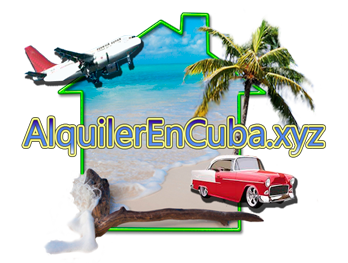
Treat your loved ones to Cuba holidays and enjoy a relaxing time with the people closest to you heart. You will surely find Cuba as an ideal destination for your getaway. The number of stunning places that you can visit here together with your family and friends is more than enough to make you want to stay longer. Before you finally set foot here, it would be a great idea to know more about this place. Read on below to get important information and facts on traveling to Cuba.
In truth, you have a world of many marvels awaiting you in Cuba, and we have a strong team ready to put together an exciting trip for you. We are always available to answer any additional questions you may have about travel to Cuba. We hope you enjoy this website.
If the purpose of your trip is to visit the beaches in Cuba, planning is essential. You will find good accommodation, save money on transportation. It will be easy to move to other areas. To continue discovering the country's natural paradises. Make a budget and plan an itinerary based on the places you want to know. One of the aspects that worries more the tourists is the transportation. Because taking a taxi to the beaches and areas of interest is expensive. It is best to negotiate rates in advance or consider the option of paying for a rental vehicle to travel by road. There are no so many possibilities to go around to the most popular beaches from Havana. The only options are to travel on the tourist bus VíaAzul or the Astros line. Both are comfortable and prices range from 8 to 44 CUC (depending on destination). For accommodation a good option to save money in your trip to Cuba is to stay in a private house “casas particulares”. That is important if you travel with your family. This gives you possibility to get to know the surroundings and relate to the locals. Also when you travel to Cuba with purpose to go to the beach you should check when are he dry and rainy seasons. Between May and October is the best climate (22-31 °C) to refresh you in the calm and crystalline waters.
The Republic of Cuba, with a population of 11 million, is the largest of the Antilles Islands, separating the Atlantic Ocean and Gulf of Mexico to the north, from the Caribbean Sea to the south. It is 1250 km (775 miles) long and ranges from 40 km to 160 km (24 to 96 miles) in width. The country consists of more than 4000 islands and keys, nearly 6000 kilometers (3600 miles) of palm and mangrove-lined coastline, almost 300 natural beaches, three major mountain ranges with numerous connecting ranges, rain forests, and broad, rich and verdant, fertile plains and valleys dotted with tall, stately palms. The climate is moderately sub-tropical with an average temperature of 24.6 C (76.3 F): in summer 25 C (77 F) and in winter 22 C (71.6 F).
The island is completely surrounded by thousands of kilometers of coral reefs containing the most diverse variety of corals, fish and other marine life to be found anywhere, with steep walls dropping from reefs to the abyss. See Scuba Diving and Snorkeling.
More than 150 species of Atlantic, Gulf and Caribbean fish abound in Cuban waters, from the majestic marlin, swordfish and sailfish, to bonefish, tarpon, snook and permit on flats and in estuaries, to snapper and grouper on the reefs. Tuna, cobia, mackeral, seatrout, jack and barracuda also abound. See Salt Water Fishing.
For the freshwater angler we offer large-mouth bass fishing as good as it gets anywhere in the world, along with other species, at more than a dozen lakes and reservoirs. See Fresh Water Fishing.
More than 20 systems of caves and caverns can be explored throughout the island, some with rivers or underwater caves connecting with the sea, many with ancient indigenous pictographs, and all with their unique living species.
One of the world's most conservation and ecology-oriented countries, Cuba offers a dozen national parks, on land and sea, covering tens of thousands of hectares, plus numerous biosphere reserves, natural parks and protected natural landscapes.
Cuban flora includes more than 6,300 varieties, 51 percent of which are endemic, and as for fauna there are 54 species of mammals, 350 species of birds, 106 reptiles, 42 amphibians, 1,400 mollusks, 15,000 insects and 1,440 arachnids.
In brief, Cuba offers the visitor one of the world's most interesting and varied nature preserves, a climate that can be enjoyed year-round and comfortable and affordable accommodations to fit any budget. Cuba, by the way, is largely free of illicit drugs, practically crime-free, and the streets and hotels are as safe as you will find anywhere. Visitors do not have to fear walking the streets at any time of day or night and, moreover, you will never find a more highly educated, polite, hospitable, and affectionate people, or a more relaxed environment anywhere. We feel certain you will want to come back for more!
Cuba is probably the most intensely diverse island destination in the Caribbean, with everything from standard fun-in-the-sun beach resort getaways to colonial city circuits, myriad land and sea adventure opportunities, tobacco and classic-car theme tours, and a wide array of cultural and artistic offerings. There's a lot to see and do in Cuba, and most travelers will have to carefully pick and choose. This section will provide you with descriptions of the country's regions, along with itineraries that will help you get the most from your visit.
Cuba is the westernmost and largest of the entire chain of Caribbean islands, located at the convergence of the Caribbean Sea, the Gulf of Mexico, and the Atlantic Ocean just 145km (90 miles) south of Florida. They say that Cuba -- if you use your imagination -- looks something like a crocodile: The head is in the east, a line of small islands form the ridges along its back, the Sierra Maestra national park forms the front legs, the Zapata Peninsula forms the rear legs, and Pinar del Río province is the tail. Cuba is in fact a closely linked string of archipelagos, made up of more than 4,000 separate little islands and cays.
Cuba's two major cities, Havana and Santiago de Cuba, are port cities with large protected harbors. Most of the island's other principal cities lie along its centerline, either right on or just off the Autopista Nacional (National Hwy.), the country's principal trade and transportation route.
Oriente is the most eastern side of Cuba, the limits with Camagüey to the west, for the north the Old Channel of the Bahamas; for the east with the Step of Winds that separates it of the island La Española (Haiti and Dominican Republic); for the south the Sea of Antilles; and for the west the Guacanayabo Gulf wich is part of the Sea of Antilles.
Since Diego Velásquez arrived to Cuba up to 1607, the whole island was considered a single political entity, all the villages responding to the governor of Cuba. With the course of the time left the island was dividing in jurisdictions.
In 1827 settled a system of three divisions for the island. In June 9 of 1878 the island of Cuba was divided in six provinces this measure was taken to be able to choose the deputies that would represent Cuba in the Spanish Government. As part of this new organization el Oriente de Cuba was divided in parties.
During the American Military Government of the (1899-1902) and the first years of the New Republic the political division of Cuba was changed. Many of the municipal terms being incorporate to bigger population's neighboring municipalities.
In 1978 a new division was made from the provinces to those that a new restructuring of the municipalities was assigned. One century after the creation of the six traditional provinces, the current government revolutionary passed a law subdividing el Oriente de Cuba in following provinces: Las Tunas, Granma, Holguín, Santiago de Cuba and Guantánamo.
The Agriculture of el Oriente de Cuba has been developed in a substantial way. This region is shown like a source of agricultural supply, where the main cultivations are coffee and cocoa. El Oriente de Cuba and their people are cheerful and hospital given to their culture a combination of strange traditions. The Industry has the nickel, which is one the main link of the cuban economy.
All the main destinations in Cuba, where you can find a particular house.
Top rated attractions by places in Cuba.
All tours that I have to offers you.
This web is the largest and friendly place to guarantee unforgettable holidays in Cuba. No reservation fees, no online payments. The payment will be done once you arrive your destination, directly to the people that will give you the services. Lots of tourists go on a package deal to areas such as Varadero, Jardines del Rey (Cayo Coco, Cayo Guillermo) or Holguin and stay in an all inclusive hotel resort. My best advice to you is to travel around the country, stay in Casas Particulares, where you will be a guest in a Cuban family's home. Hire a car or take the Viazul Bus, whatever, Cuba is easy to do on your own and much cheaper when you arrange it yourself, trust me. Have dinner in the casas, talk to the Cuban people, mingle with the locals and feel ... La Vida Cubana.

Around Viñales, in the western province of Pinar del Rio, are a unique string of rounded limestone mountains called mogotes; in their shadows are the lush green fields that produce the world's finest tobacco leaves.
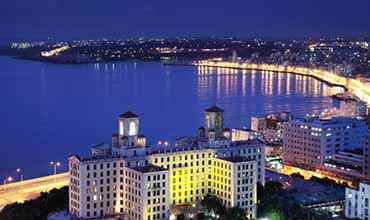
Havana is probably the most splendid example of Spanish colonial architecture in Latin America. Much of the historic centre has been carefully restored. The absence of the outward manifestations of international commerce - advertising billboards...
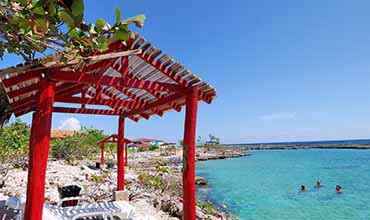
The best-known of Cuba's wildlife havens, the Zapata Peninsula, 156 km southeast of Havana, is a refuge for many bird and animal species. The scenery is spectacular: flamingos swoop across the milky lagoons...The region is a nature reserve.
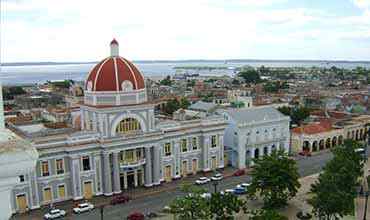
Cienfuegos City is called "The Pearl of the South" because of the impressive beauty of its bay; because of its seductive city which provokes the wonder of all who know it, and because of that innate nobility which characterizes those born in Cienfuegos.
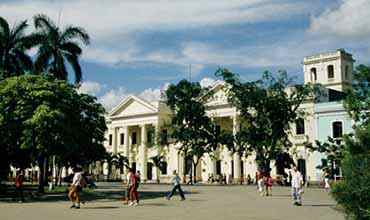
Around Viñales, in the western province of Pinar del Rio, are a unique string of rounded limestone mountains called mogotes; in their shadows are the lush green fields that produce the world's finest tobacco leaves.
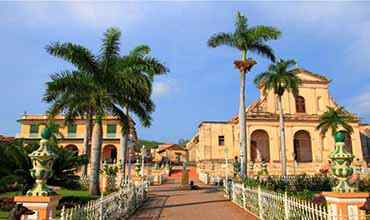
Trinidad is a small and peaceful city located between the sea and a range of rolling verdant hills. It pays homage to an illustrious past by remaining perfectly preserved since colonial times. There are fine churches and red-tiled mansions lining...

Camaguey is also known as the City of Tinajones, due to the widespread use of those large recipients of water made of cooked clay. Camaguey (known under this name since 1903) has a very particular urban construction style with narrow and tortuous streets that always end in squares and plazas, where we can still see buildings of outstanding historical, social and architectural value.
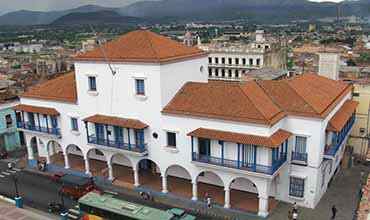
Nestled alongside a sweeping bay at the foothills of the Sierra Maestra mountains, Santiago is Cuba's most exotic and ethnically diverse city. Santiago is renowned for producing much of Cuba's most important music, and this rich musical tradition, mingled with the remnants of French customs, gives the city a sensual, even sleazy, New Orleans-like atmosphere.

Baracoa is a land of great rainfall and many rivers. The lush vegetation, the high mountains covered with long-lived forest, the customs that have been handed down from one generation to another and the appearance of a town that has remained unchanged over a long time are, undoubtly, key ingredients in the special attraction of this tiny city on the shores of Miel (Honey) Bay.
Steeped in faded grandeur, Cuba, the Caribbean's largest island, drips with history, culture, and a captivating mystique. Live music wafts through the cobbled squares in Havana's World Heritage-listed Old Town, vintage cars still cruise the streets, and the beautiful old buildings of Cuba's colonial cities evoke the feel of a country frozen in time. Cuba also abounds in natural beauty. This vast island has more than 3,000 kilometers of coastline, much of it rimmed by dazzling beaches. Coral reefs glimmer in the turquoise waters, and Cuba's lush countryside and sublime islands have played host to presidents, provided refuge to revolutionaries, and inspired writers from around the world, Hemingway among them. With all this history and beauty as well as superb diving and fishing, Cuba offers a depth and diversity few Caribbean islands can rival.
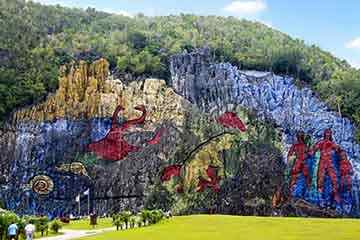 2024
2024
A UNESCO World Heritage Site, the Parque Nacional Vinales is a beautiful, verdant valley in the Sierra de los Organos, north of Pinar del Rio. Steep limestone hills called mogotes slice through the valleys creating a dramatic landscape. The valley floors in the Parque Nacional Vinales are agricultural areas where tobacco, fruit, and vegetables are grown.
For outdoor enthusiasts, the park offers fantastic hiking and horseback riding in the hills. Nearby, the charming town of Vinales is a great base for exploring the surrounding area.
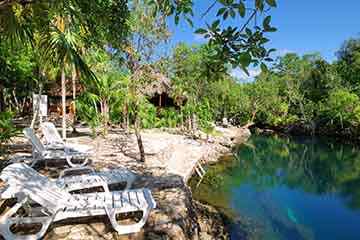 2024
2024
A haven for birders and nature lovers, the Peninsula de Zapata is a remote, sparsely populated area of Cuba with diverse landscapes and one of the largest wetlands in the Caribbean. The Cienaga de Zapata, or the Zapata Swamp as it is affectionately known, is a UNESCO Biosphere Reserve, home to approximately 150 different species of birds, including rare bandicoots, waterhens, parrots, and heron.
Crocodiles are also common. One part of the peninsula is a designated nature reserve, the Gran Parque Natural de Montemar, where visitors can see some of these creatures in their natural habitats.
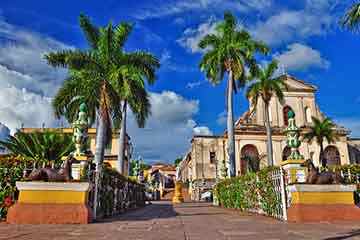 2024
2024
Exploring the town of Trinidad, a UNESCO World Heritage Site, is like stepping back in time. The beautifully restored buildings and cobblestone streets in the city center imbue a quaint colonial feel. Much of the architecture dates from the 17th to the 19th century when Trinidad prospered from both the sugar and slave trades.
Today, Trinidad is one of Cuba's most popular tourist towns and the streets are often packed with foreigners. ravelers can soak up the lively ambiance of this charming city in the cobblestone Plaza Mayor, the city's central square. Above the square stands the Neoclassical Church of the Holy Trinity (Iglesia Parroquial de la Santisima Trinidad).
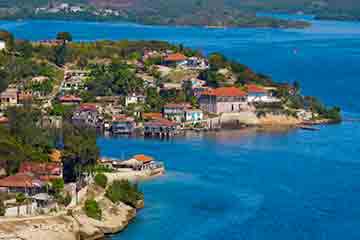 2024
2024
Cuba's second largest city, Santiago de Cuba, is the most “Caribbean” of the island’s cities, greatly influenced by immigration and trade from other Caribbean islands. It is proud of its revolutionary heroes, beautiful squares and vibrant musical tradition. And it is known particularly for its carnival.
Founded by Spanish conquistadors in 1515, Santiago de Cuba’s revolutionary past has been scarred by pirate attacks, Spanish domination and US military intervention. For its heroic role, the city was awarded the title, “City of Heroes” in 1984.
Vinales is considered one of the most important tourist destinations in the country, so much so that it has been stated in the travel section of the influential New York Times at number 10 among the top 52 destinations to visit in 2016. Vinales is one of the most beautiful natural environments in Cuba, embedded in "Sierra de los Organos" was declared a National Monument in 1979, was also approved in 1999 as National Park and in December of that year, it was declared by UNESCO World Heritage Humanity, in the category of Cultural Landscape. The area is ideal for nature tourism and adventure (hiking, caving and climbing) and mountaineering enthusiasts can find their challenges there as well. Viñales stands out more for the environment than their points of interest, since almost all activities carried out are outdoors. Vinales is a quiet and friendly people where travelers come to relax and enjoy the wonderful nature, relax and sit in the town square, where you can visit the House of Culture, the Art Gallery, the recently restored Church and Polo Montañés cultural center. To the west, a little separated from the center you can find Adela Azcuy the Municipal Museum, former home of a heroine of the independence wars where you can also book excursions. In the opposite direction (east) is the Garden of "Caridad" extensive garden adorned with plastic doll heads and full of flowers and plants.
In Old Havana, a UNESCO world heritage site, the past is palpable. Rumba riffs roll through quaint cobbled squares; vintage cars ply the streets; and historic forts, museums, and beautifully restored architectural gems share the stories that shaped this grand city. For a sensory feast, Old Havana is best explored on foot. Meander along the narrow lanes, chat to the locals, climb the Spanish-built fortresses, feel the pulse of the music, and savor a coffee at one of the charming plazas where Cuban Baroque meets Art Nouveau.
Ciénaga de Zapata, considered a Biosphere Preserve and officially declared RAMSAR Site, is for sure one of the best places of the Island regarding beauty, biodiversity and historical values. Located to the southern coastline at Matanzas city,at 180 km to the south of Havana city,it is also the major humid area of the insular Caribbean, and a natural fragile ecosystems reservoir. With 4 520 km,it is the place of the Parque Nacional de Ciénaga de Zapata, accessible by road. Its inhabitant number is around nine thousand, with a density of barely six per Km2, the lowest in Cuba. Sea-freatic–tectonic caves area a special type of cave very abundant here, open all the long of a 70 km crack between the Bay of Pigs and Cienfuegos bay. In their surface there are semicircular lakes, which allow the access to flooded galleries, some of which serve as course for underground rivers. Another attraction is the Laguna del tesoro (treasure lake), with more than 4 m of average depth and almost 16 km of surface, which make it one of the major fresh water mirrors of the Island. According to an old legend, in the XIX century, when Spaniards went deep into that area, the first local inhabitants, being frightened, threw their riches to the water, which originated the name of the lake. Villa Guamá is also located here, and it is one of the most famous and visited of The Ciénaga de Zapata, due to its natural beauty and colorful architecture. There, several sculptures of Rita Longa recreate the daily activities practiced by the first local inhabitants. There is also a peculiar flora, found under the water, floating over it and by the shore. Among its fauna, we find biajacas, trouts, the cebrita cubana (Cuban zebra), the cabezota, as well as turtles and bullfrogs. Manjuari, a living fossil found in the access channels, and the manati, another traditional Cuban species, are an example of the local preservation tasks carried out. All of these reasons have turned this area into a place more and more known and preferred by ecology, sport and recreational fishing lovers. In the same way,in the Parque Nacional Ciénaga de Zapata, considered one of the most important Cuban birds hibernation centers, there are important natural areas. An example of this are the Salinas de Brito, a relevant preserve for aquatic birds like sevillas,herons, flamingos and cranes, and ideal for tourism of observation. On winter, more than 65 bird species coincide here, while in the Ciénaga de Zapata are 16 types of reptile, among them the Cuban cocrodile, which can be observed at the local breeding farm. A wide eco-tourist offer and an efficient specialized guide and equipments service are available for visitors to be in direct contact with nature.
Located on the site of an ancient aboriginal town that due to the presence of an enormous, isolated, and well protected bay became an important center of piracy in the Caribbean, this city was founded in 1819 with the name of Villa de Fernandina de Jagua. Although in 1745 the Spanish colonial authorities had built a solid fortress in this place--which still exists, elegant and above all marine--this city shows interesting places of neoclassic inspiration as well as extraordinary monuments, like the Valle Palace, the Terry Theater, the Prado Promenade, and the Martí Park, among others. The historical central area of Cienfuegos has been declared a World Cultural Heritage Site by UNESCO’s Committee of World Patrimony, which considered it an exceptional architectural example of the modern ideas of order for city planning developed in The Americas of the 1800’s. The beautiful landscapes of the Escambray Mountains are near this city, while the province’s coast treasures rare and exotic beaches, such as Rancho Luna and the insular platform, with a spectacular seabed suitable for diving.
The city of Santa Clara is best known as the place where the dictator Batista surrendered to Che Guevara in 1958. The province of Villa Clara is also noted for its production of sugar, coffee and tobacco. A recently built causeway linking the mainland to the offshore islets has helped open the beach areas to tourism. In 1958, guerilla troops commanded by Ernesto Che Guevara attacked the industrial centre of Santa Clara after a hard, 400-kilometre march that had begun in the Sierra Maestra mountains. The dictatorship finally surrendered to Guevara’s troops. The province of Villa Clara is a traditional sugar producer. Excellent coffee grows on its southern mountain slopes, as does one of Cuba important tobacco crops. A recently built causeway linking the mainland to the keys has helped open the beaches to tourism.
Nudging the emerald Escambray mountains, Trinidad is a UNESCO World Heritage Site and one of Cuba's most charming towns. So perfectly preserved are the quaint colonial buildings, the entire town feels as though it's trapped in a time warp from the 18th century. Stroll the winding cobbled streets here to discover a trove of architectural treasures, from colorful colonial mansions to historic churches and pastel-painted bell towers with panoramic views. Most of the buildings span the 17th to 19th centuries when the town prospered from the sugar and slave trades. Trinidad is also a great base for day trips to the mountains and the sea. From here, sightseers can hike to waterfalls in the Sierra del Escambray; bike to the pretty Playa Ancon, a palapa-studded beach; or venture into the Valle de Los Ingenios, yet another World Heritage-listed gem.
A cradle of Cuban culture, Camaguey—the “City of Tinajones”—lies in the heart of cattle country and was laid out with irregular streets designed as a convoluted maze to thwart pirates. The historic centre is full of well-preserved colonial plazas and cobbled streets featuring antique churches and convents, and by colourful 17th- and 18th-century domestic buildings featuring red-tile roofs, lathe-turned wooden window grills, and spacious interior courtyards adorned with the city’s trademark oversized jars called tinajones. Camagüey is the third largest city in Cuba and a unique example of the colonial times in the country due to its maze-like street layout with many narrow and irregular streets, complicated junctions, and multiple squares. The best way to experience Camagüey is to get lost walking around the vast historical center without a pre-defined plan while admiring the interesting buildings of this colonial town, including many churches and colorful houses. Highlights include Plaza de los Trabajadores, Catedral de Nuestra Señora de la Candelaria on Parque Ignacio Agramonte, and Plaza San Juan de Dios.
Santiago de Cuba is the second largest city in Cuba and a historical and cultural treasure. The city is often regarded as the root of the Cuban Revolution, and the many museums here retrace key events from this important period of Cuba's history. But unlike Trinidad, which seems frozen in time, Santiago de Cuba mixes modern architecture and industrial developments with its colorful colonial gems and historic fort. This bustling metropolis is also home to one of the country's most prominent universities, giving it a young and vibrant edge. Shaped by its rich mix of cultures and Afro-Caribbean heritage, the city is often said to be the most Caribbean city in the country. Today, travelers can experience this multi-cultural vibe in the eclectic music, diverse architecture, art galleries, and lively festivals. Day trips are also appealing from here. Not far from the city, tourists can visit a famous pilgrimage site, or hike to the top of a rocky summit for inspiring views across mist-shrouded peaks.
Once upon a time, not all that long ago, it wouldn’t matter if a list of things to do in Baracoa was about the most tempting thing you’d ever heard of in your life, since it was practically impossible to get there. In the 1960s a road was built through the Sierra del Purial mountains that surround the town, connecting Baracoa with the rest of Cuba. Before this, much of Cuba didn’t make their way to the beauty of Baracoa except for the two or three weekly flights from Havana on Baracoa’s small regional airport on Russian-made airliners. Times might have changed (although not all that much in Cuba), and the town is still gloriously isolated. There are still just a handful of flights into the town each week, and that road through the mountains has not been expanded in any major way. And yet this is the appeal of Baracoa. You will be surprised that more visitors don’t actually make the effort to come to this part of Cuba, particularly those who love nature and also love to fill their stomachs. So what is it that makes this luminous town so special? Cuba’s oldest Spanish settlement, is slightly different than any other Cuban city. It’s a municipality of Guantánamo Province very close to the eastern tip of Cuba. Much higher amount of rainfall, makes it the region of lush, almost subtropical vegetation. After all, Baracoa is all about cocoa and coconut plantations and their products. Despite being hard to reach, it shouldn’t be missed in any Cuban trip, even if you only have one day time to spend in Baracoa. You can explore cocoa and coconut plantations, enjoy the taste of Baracoa cuisine, spend an afternoon at the beach and still have a plenty of time for learning some salsa moves at night.
"Esta es la tierra mas hermosa que ojos humanos han visto." [This is the most beautiful land that human eyes have ever seen.] - Christopher Columbus, upon arriving in Cuba, October 28, 1492.
Cuba is more than the largest island in the Antilles. It is an intricate archipelago comprising the main island (two-thirds the size of Florida), the Isle of Youth, and 4,195 keys [cayos] and islets. Their combined surface area is some 42,854 square miles. The country sits at the mouth of the Gulf of México, 87 miles from the Bahamas, 91 miles from Jamaica, 90 miles from Florida and 130 miles from Cancún.
Cuba has produced major international figures in literature and fine arts, film, ballet, modern dance and theatre. The country is also renowned for its original rhythms such as the danzón, son, bolero, mambo, cha cha chá and more. Cuba's prestigious cultural events attract international celebrities in dance, music, theatre and other arts. Among these events are the Casa de las Américas literary contest, the Havana International Ballet Festival, the Festival of New Latin American Cinema and the International Jazz Festival.
AlquilerEnCuba is a constantly evolving website, that's why your opinions and suggestions are very important, because in this way we will know your expectations and needs for our service. Our service is free and legal, there are no online payments, no hidden fees. We have direct contact with the owners of the Casas Particulares we announce and assure they are all properly authorized by the Cuban government.